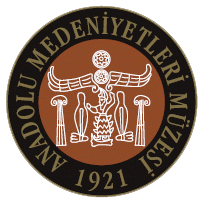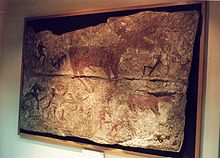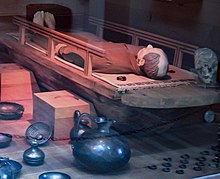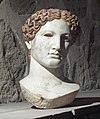Museum of Anatolian Civilizations
| Data | |
|---|---|
| place | Ankara |
| Art |
Archaeological Museum
|
| architect | Macit Kural, Zühü Bey, İhsan Kıygı |
| opening | 1943 |
| Number of visitors (annually) | 271,857 (2009) |
| operator |
Ministry of Culture and Tourism of the Republic of Turkey
|
| management |
Melih Arslan
|
| Website | |
The Museum of Anatolian Civilizations ( Anadolu Medeniyetleri Müzesi in Turkish ) in Ankara , also known as the Hittite Museum , is the most important archaeological museum in Turkey alongside the Arkeoloji Müzesi in Istanbul . It is located in the Atpazarı district in the old town of Ankara below the citadel .
Although originally planned as a central collection point for evidence of the Hittites , the museum today shows exhibits from all periods from the Stone Age to modern times. However, the focus is on the epochs up to the beginning of the first century BC, again mainly on the Hittite legacies. The time from classical antiquity to the Ottoman Empire is only represented in selected pieces, mostly from Ankara and the surrounding area.
The European Museum Forum has awarded the museum the “ European Museum of the Year 1997” award. The Hittite cuneiform texts from Boğazköy exhibited here are part of the UNESCO World Document Heritage .
history
building
Today's museum is housed in two buildings from Ottoman times , the former covered bazaar Mahmut Paşa Bedesteni and the Kurşunlu Han caravanserai . Den Bedesten (Turkish for Covered Bazaar , from bazistān /بزستان/ 'Stoffmarkt') had Grand Vizier Mahmud Pasha built in the years 1465–1471. It is said that fabrics made from angora wool were traded here. The closed room, corresponding to the usual type of bazaar buildings, is vaulted by ten domes and enclosed by a gallery in which there were 102 brick-vaulted shops.
The Kurşunlu Han, a caravanserai, was created according to official documents by Rum Mehmed Pasha , Mahmud's successor as Grand Vizier Sultan Mehmed II . There is no building inscription so that an exact dating is not possible. From coins from the time of Murad II. (1421-1451 r.), Which were found during the restoration in 1946, it can be concluded that the building already existed in the 15th century. The Han is of the Ottoman caravanserai type. The inner courtyard is surrounded by a portico and 28 rooms on the ground floor and 30 on the first floor. A stable was housed in the western and southern parts. There were 24 shops on the north and east sides, four of them in the east gate. After a fire in 1881, the two buildings were abandoned and fell into disrepair.
museum
A first archaeological museum existed in Ankara in 1921 in a defense tower of the Akkale fortress under the direction of cultural director Mübarek Galip Bey. Finds were also exhibited in the Augustus Temple , where the Monumentum Ancyranum was found next to the Hacibayram Mosque , and in the Roman bath .
After Mustafa Kemal Ataturk's suggestion came up with the plan to create a central Hittite museum in the 1930s, restoration work on the two buildings began in 1938 under Cultural Director Hâmit Zübeyir Koşay and Science Minister Saffet Arıkan . They lasted until 1968. The architect Macit Kural created the plan for the restoration of the central dome of the Bedesten, the actual work was led by Zugtü Bey following a public tender, and İhsan Kıygı was responsible for the restoration of the surrounding shops.
In 1940, parts of the renovation work in the main room of the bazaar building had progressed so far that the installation of the exhibits could begin under the direction of the German archaeologist Hans Gustav Güterbock . Finally, in 1943, the first part, the current central hall with the Hittite monumental works, was opened to visitors. Since its final completion in 1968, the former Kurşunlu Han has housed administration rooms as well as a library, laboratories, workshops and other research rooms, while the former bazaar is used as an exhibition room.
Goal setting
In the 1930s, the Turkish history thesis emerged in Turkey , according to which Asia Minor had been inhabited by immigrants of Turkish origin from prehistoric times. Ataturk was one of her followers. After Hugo Winckler had identified Boğazköy as Hattuša , the capital of the Hittite empire, Mustafa Kemal suggested that a Hittite museum should be founded to prove that they were also of Turkish descent. After Hittite was classified as an Indo-European language, the thesis was later abandoned and at the time of completion the museum was dedicated to all Anatolian civilizations, with the emphasis still on Hittite.
exhibition
The exhibits in the outer halls are arranged in a counter-clockwise direction from the main entrance in the north, starting with the Paleolithic up to classical antiquity and modern times . In the central hall there are orthostat reliefs and large sculptures from the Hittite and Phrygian times.
Paleolithic (Paleolithic)
In the entrance hall there are Paleolithic finds from the Karain Cave near Antalya , including skeletons, skulls and teeth of the Neanderthal man , stone tools and axes, as well as needles and jewelry made from bone. They are the oldest finds in Turkey, some of the finds could be dated more than 400,000 years ago.
Neolithic (Neolithic)
In the first part of the west hall artefacts from the Neolithic period from Çatalhöyük and Hacılar Höyük in southwestern Anatolia can be seen; they date back to between 6500 and 5600 BC. Dated. Wall paintings from Çatalhöyük are to be mentioned, which are applied in red, pink, brown, black and white paint on beige clay brick plastering, as well as the model of a room with bulls' heads and statuettes of goddesses, including the so-called Venus of Çatalhöyük, the statuette of a mother goddess as a mother goddess Woman giving birth on a throne (picture below). The found objects from Hacılar are mainly polished clay pots.
Chalcolithic (Copper Age)
In the adjoining area there are objects from the Copper Age (5000 to 3000 BC). Monochrome, polished and increasingly colorful ceramic products come from Hacılar, from Canhasan in southern Anatolia monochrome as well as red and black painted ceramics, further specimens of terracottas of the mother goddess, as well as copper finds, including a bracelet. A silver ring, copper implements, needles and a fragment of a dagger were found in Beycesultan in western Turkey. The ceramics there are gray, black or brown in color and are partially painted with white patterns. From Alişar Höyük and Alacahöyük in northern Central Anatolia, pottery in brown, black or dark gray can be seen, decorated with stripes and incised patterns. From Tiliktepe near Van , objects made of obsidian are shown, which are associated with the Halaf culture .
Early and Middle Bronze Age

The second part of the west hall contains finds from the so-called princely graves of Alacahöyük . They come from the time of the Hattier and are made into the late third millennium BC. Dated. The best known are called standards , they are openwork bronze disks with geometric patterns, sun and animal representations, some with inlays made of gold and silver and with a clip-on device. They are interpreted as essays for the funeral car with which the princes were brought to the grave.
One of the standards with three deer figures and bull horns was placed on the central Sıhhiye Square in Ankara, magnified many times over . Other grave goods from these graves, which have been used by the local rulers for several generations, are items made of gold, silver, electron , bronze, amber, agate , rock crystal, iron and baked clay. These include jewelry such as tiaras, chains, bracelets, buckles and earrings, but also vessels and weapons made of bronze and gold, as well as statuettes, depictions of the mother goddess and Siatra .
Further finds from the early Bronze Age are on display in the south hall . Here you can find relics from Alışar Höyük , Kültepe and Beycesultan, mostly vessels and idols made of clay from the period 3000 to 1950 BC. This also includes numerous objects from the time of the Assyrian trading colonies (1950 to 1750 BC), the sites are also Alışar Höyük and Kültepe (Kanesch) as well as Acemhöyük and Boğazköy . You can see cuneiform tablets , cylinder seals , clay figures and gold jewelry.
Time of the Hittite Empire
The finds from the late Bronze Age, with the exception of the large orthostat reliefs , are located in the eastern part of the south hall. Most of them were excavated in the area of today's Çorum province, i.e. in the heart of the Hittite empire around the capital Hattuša . The objects are between 1750 and 1200 BC. BC originated. Here are clay vessels, including tubs, canteens, vessels with sieves and kantharoi , some of them in animal form (bulls, ducks), bronze statuettes, but also seals and cuneiform documents.
The latter include copies of the peace treaty between the Hittite and Egyptian empires after the battle of Kadesh , which is the first known written peace treaty in history. Another noteworthy written testimony is a bronze plaque measuring 23.5 × 34.5 cm, which was found in Hattuša in 1986 and the text of which contains a border correction. This is the only bronze cuneiform document found in Anatolia. These tables with documents in the Hittite language were added to the World Document Heritage Archives in 2001.
Phrygians
The showpiece from the Phrygian Empire (1200–700 BC) is a replica of the burial chamber from the large tumulus (barrow) of Gordion , in which King Midas is possibly buried. In the south and east halls you can still see Phrygian bronze vessels, for example kettles, bowls, plates, sieve jugs, ladles and numerous bronze brooches , which also come from Gordion and the surrounding area. Also worth seeing are wooden furniture, decorated with geometric patterns, but also wooden sculptures of horses, lions and bulls as well as wooden reliefs with mythological scenes that came to light in a relatively good state of preservation from the tumulus of Gordion and other nearby tumuli.
Phrygian ceramics made on the potter's wheel include monochrome products and colored ceramics. The monochrome vessels usually have a black or gray coating, the colored ceramics are painted on a reddish-brown and light coating. Geometric patterns, squares, triangles, zigzag bands, loop band and checkerboard patterns that completely cover the vessel, as well as image fields with depictions of animals appear.
Urartians
From the kingdom of Urartu in the area around Lake Van , which had its heyday in the 9th and 8th centuries BC. BC, finds from Toprakkale , Altıntepe , Anzavurtepe , Çavuştepe , Adilcevaz , Kayalıdere and Van are exhibited. The ornate ivory carvings , which are mostly part of furniture, are particularly noteworthy. They show griffins, faces, deer and lions, among other things. Bronze objects that were also exported to Phrygia, Greece and Italy can also be seen, for example kettles with ornamental figures, belts, shields, helmets, votive tablets, horse harness and quivers, as well as stamps and cylinder seals.
Lyder
Lydian remains are represented by the finds from the Harra tumulus near Kırkağaç in the Manisa province and from the Aktepe tumulus near Uşak , both in western Anatolia, which became known as the Lyderschatz in the 1960s . It consists primarily of bowls and pieces of jewelry made of precious metal, as well as seals and fragments of frescoes. The time of origin of the exhibits was the second half of the 6th century BC. Chr.
Classical antiquity to modern times
In the last room of the eastern part you can see statues, statuettes, ceramics, jewelry and coins from the Greek , Roman , Seljuk and finally Ottoman times. These are no longer arranged according to epochs, but according to material groups.
Hittite and Phrygian orthostat reliefs and sculptures
Finally, in the central hall there are large sculptures from the time of the Hittite Empire (1450–1200 BC) and the epoch of the late Hittite minor kingdoms (1200–700 BC), as well as some large Phrygian sculptures . The two monumental sphinxes and the series of reliefs from the city gate in Alacahöyük are remarkable . They show gods and processions, but also animals, hunting scenes and a so-called juggler's scene with musicians and probably acrobats.
In the passage to the western part is the well-known half-relief of a warrior god from the King's Gate in Hattuša. From the late Hittite period, the reliefs from Karkemiš should be mentioned with King Araras , playing royal children, a funeral procession, charioteers and a profile relief of the city goddess Kubaba . The works from this period already show Assyrian influences, as well as those from Arslantepe near Malatya . Among these is a relief of the local king Sulumeli, who offers a libation to the gods. There is also a pair of sphinxes and a portal lion from Sakçagözü , as well as horse, bull and lion reliefs from the Phrygian times, found near Ankara. Other reliefs and steles come from Sultanhanı bei (Kayseri), Köylütolu and Andaval .
Basement
In the basement, selected finds from Ankara's archeology are exhibited, which form a small, regionally focused excerpt from the museum's collection. Since Ankara has only existed as an urban settlement since the Phrygian era, a relatively large number of pieces from the classical period can be seen.
Outdoor area
In the garden area in front of the main entrance, individual finds from different epochs are set up; the replica of the large Hittite sculpture from Fasıllar is remarkable . This collection continues on the west side of the building with stone sculptures, building fragments and steles from classical to Ottoman times that were found in Ankara and the surrounding area.
activities
The museum has been publishing a yearbook ( Yıllık in Turkish ) since 1986 . It was and is still involved in numerous excavations, including the Temple of Augustus, the Roman theater and the Roman bath in Ankara, in Şereflikoçhisar , Iuliopolis , Haymana -Bahçecik in the Ankara province and at the tumulus of Kurtsivrisi in the Kırıkkale province .
During rescue excavations on the Sinap formation under the direction of Berna Alpagut, a second specimen of an Ankarapithecus skull was found in 1995 , which was restored in the museum and is now on display. It has been dated to 9.8 million years.
literature
- Marianne Mehling (Hrsg.): Knaur's cultural guide in color Turkey. Droemer Knaur, Munich 1987, ISBN 3-426-26293-2 .
- İlhan Temizsoy, u. a .: Museum of Anatolian Civilizations. Ankara, ISBN 975-7523-03-8 .
- Literature on the Museum of Anatolian Civilizations in the catalog of the German National Library
Web links
- Official website of the museum (Turkish)
- Official website of the Ministry of Culture (Turkish)
- Anatolian Civilizations Museum
Individual evidence
- ↑ January 1, 2009 to December 31, 2009 Tarihleri Arası Ziyaretçi Sayıları . General Directorate for Monuments and Museums (XLS file; 67 kB).
- ↑ Şehabeddin Tekindağ: Mahmud Paşa. In: Türkiye Diyanet Vakfı İslâm Ansiklopedisi. Vol. 27, TDV Yayını, Ankara 2003, p. 376.
- ↑ İlhan Temizsoy, u. a .: Museum of Anatolian Civilizations. Ankara, ISBN 975-7523-03-8 , p. 5.
- ↑ İlhan Temizsoy, u. a .: Museum of Anatolian Civilizations. Ankara, ISBN 975-7523-03-8 , p. 7.
- ↑ Esra Özyürek: The politics of public memory in Turkey. Syracuse University Press, Syracuse 2007, ISBN 978-0-8156-3131-6 , p. 47 ( on GoogleBooks ).
- ^ Metin Kartal: Karain Mağarası Kazıları 2007. Excavations at the Karain Cave in 2007. In: ANMED. News of Archeology from Anatolia's Mediterranean Areas. No. 6, 2008, pp. 24–28 ( PDF file; 658 kB ).
- ↑ Marianne Mehling (Ed.): Knaurs Kulturführer in Farbe Turkey. Droemer Knaur, Munich 1987, p. 49.
- ↑ Homepage of the museum - Yıllıklar (Turkish)
- ↑ Homepage of the museum - Kazılar (Turkish)
- ↑ Homepage of the museum - Sinap Formasyonu Kurtarma Kazısı (Turkish)
- ^ Alan M. Greaves, Barbara Helwing : Archeology in Turkey: The Stone, Bronce and Iron Ages in American Journal of Archeology , Vol. 105, no. 3 (July 2001), p. 469 Jstor
Coordinates: 39 ° 56 ′ 18 ″ N , 32 ° 51 ′ 43 ″ E
















